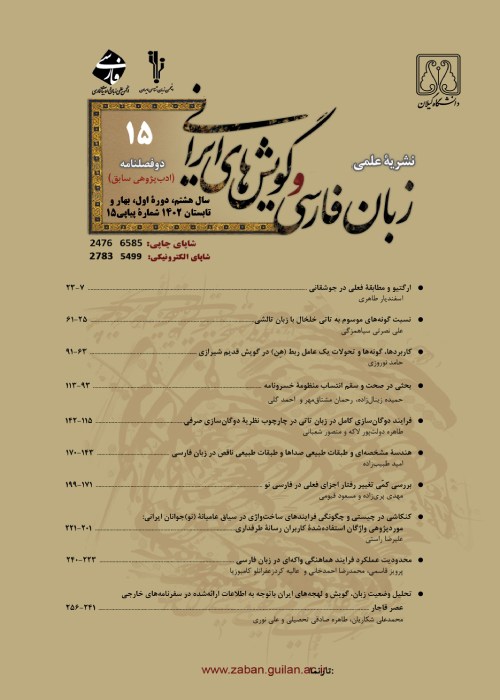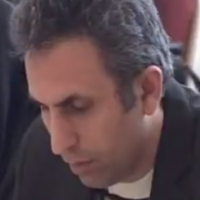The Tense of possible worlds in conditional constructions of Modern Persian
Author(s):
Article Type:
Research/Original Article (دارای رتبه معتبر)
Abstract:
Introduction
Conditional construction is a linguistic universal that occurs systematically across natural languages, potentially true for all of them. The conditional sentence is a compound statement composed of two main and subordinate clauses namely apodosis and protasis respectively. Most languages use conditional connective words to mark this construction. In Persian, “agar” has the most frequency among the conditional connective words. Except this word, there are some other connective words that can be used as a conditional connective word such as “tâ, čonanče, vaGti, hargâh, be šarte inke, hattâ agar,…”. Regarding the importance of conditional construction, this study examines verb’s tense of the protasis and apodosis clauses of the conditional sentences in the contemporary Persian language based on the theoretical framework of Declerck and Reed (2001).
Theoretical framework
Declerck and Reed (2001: 65-66) have proposed a kind of typology for the different types of possible worlds cross-linguistically. Possible world is a situation in which things and incidents exist or could exist. Whereas a real possible world is a situation in which things really exist, an unreal possible world is a situation in which they could exist. Based on this typology, the possible world of a protasis clause can be factual or theoretical. In the case the possible world is theoretical, it can be neutral or non-neutral. The non-neutral possible world itself is divided into closed, open, tentative and counterfactual worlds. The canonical pattern of tense system in languages of the world portrays a distinction between past and non-past or future and non-future tenses. English and Persian use a dual distinction between past and non-past tenses. In this research, we aim to examine the tense of the protasis and apodosis clauses based on the type of the possible worlds of protasis clauses.
Methodology
In order to investigate the tense of the protasis and apodosis clauses in the conditional sentences of Modern Persian, we selected 10 fiction books of the most famous contemporary Persian authors. Selecting approximately 5000 words and 25 pages of each book randomly, we extracted conditional sentences through the sample. The corpus involving 50622 words and 254 pages, showed 286 conditional sentences. To derive the tense of the possible worlds, the type of the conditional construction of each conditional sentence was determined based on the theoretical framework of Declerck and Reed (2001) and the tense of the protasis and apodosis clauses was analyzed using the statistical calculations. Finally, we examined the relationship between the type of the conditional construction and the tense of the protasis and apodosis clauses.
Results & Discussion
The present contribution presented an attempt to investigate the probability of occurrence of past and non-past tenses of the protasis and apodosis clauses separately with regard to the data and the use of computations and statistical analysis methods. The study identified that the tense variation of protasis and apodosis clauses in Persian is fewer than the English cognates . It was also argued that Persian represents a strong tendency in applying clauses that the tense of protasis and apodosis is non-past to be of the “open” division. On the other hand, we demonstrated that there is a strong tendency for the tense of protasis and apodosis being in the past to be of factual characteristics. The study concluded that as for the open conditionals, the speaker often uses conditional construction to portray a situation which, as yet, has not occurred or could later occurr. Therefore, the tense is often non-past. On the other hand, exploiting factual conditional, the speaker represents a situation believed in the truth of its occurrence. Therefore the past tense will serve to express the factive situation.
Conclusions & Suggestions
Examining the corpus of the present research, we concluded that Persian conditional sentences can be classified according to Declerck and Reed’s typology. It was further indicated that in Modern Persian, the types of conditional constructions address factual, neutral, closed, open, tentative and counterfactual divisions. We also showed that the past and the non-past tense of the protasis clause were almost equal-with the non-past to be slightly more than the past- while in the apodosis clause, non-past tense was more than the past form. Furthermore, the study exhibited that there is a tendency between the tense of the protasis and apodosis clauses and the conditional type in Modern Persian; however, the tendencies are not absolute and it is not possible to guess the type of conditional construction certainly based on the tense of the verbs. Investigating the relationship between the modal meanings of protasis and apodosis clauses and the type of conditional constructions will be performed in further studies.Keywords:
Language:
Persian
Published:
Journal of Persian language and Iranian dialects, Volume:3 Issue: 2, 2019
Pages:
55 to 71
https://magiran.com/p2008719
دانلود و مطالعه متن این مقاله با یکی از روشهای زیر امکان پذیر است:
اشتراک شخصی
با عضویت و پرداخت آنلاین حق اشتراک یکساله به مبلغ 1,390,000ريال میتوانید 70 عنوان مطلب دانلود کنید!
اشتراک سازمانی
به کتابخانه دانشگاه یا محل کار خود پیشنهاد کنید تا اشتراک سازمانی این پایگاه را برای دسترسی نامحدود همه کاربران به متن مطالب تهیه نمایند!
توجه!
- حق عضویت دریافتی صرف حمایت از نشریات عضو و نگهداری، تکمیل و توسعه مگیران میشود.
- پرداخت حق اشتراک و دانلود مقالات اجازه بازنشر آن در سایر رسانههای چاپی و دیجیتال را به کاربر نمیدهد.
In order to view content subscription is required
Personal subscription
Subscribe magiran.com for 70 € euros via PayPal and download 70 articles during a year.
Organization subscription
Please contact us to subscribe your university or library for unlimited access!



